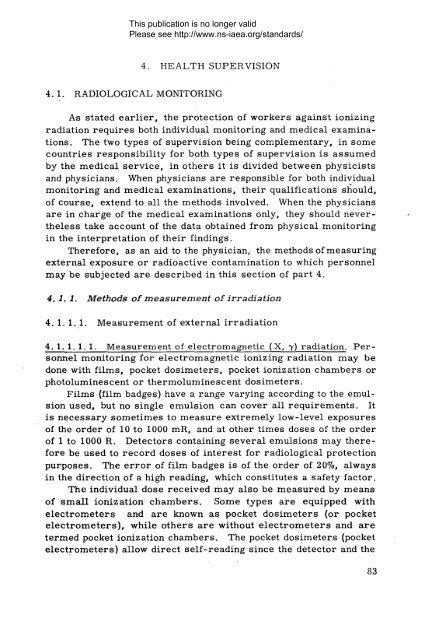Safety_Series_025_1968 - gnssn - International Atomic Energy ...
Safety_Series_025_1968 - gnssn - International Atomic Energy ...
Safety_Series_025_1968 - gnssn - International Atomic Energy ...
You also want an ePaper? Increase the reach of your titles
YUMPU automatically turns print PDFs into web optimized ePapers that Google loves.
This publication is no longer validPlease see http://www.ns-iaea.org/standards/4. HEALTH SUPERVISION4. 1. RADIOLOGICAL MONITORINGAs stated earlier, the protection of workers against ionizingradiation requires both individual monitoring and medical examinations.The two types of supervision being complementary, in somecountries responsibility for both types of supervision is assumedby the medical service, in others it is divided between physicistsand physicians. When physicians are responsible for both individualmonitoring and medical examinations, their qualifications should,of course, extend to all the methods involved. When the physiciansare in charge of the medical examinations only, they should neverthelesstake account of the data obtained from physical monitoringin the interpretation of their findings.Therefore, as an aid to the physician, the methods of measuringexternal exposure or radioactive contamination to which personnelmay be subjected are described in this section of part 4.4. 1. 1. Methods of measurement of irradiation4. 1. 1.1. Measurement of external irradiation4. 1. 1. 1. 1. Measurement of electromagnetic (X, 7 ) radiation. Personnelmonitoring for electromagnetic ionizing radiation may bedone with films, pocket dosimeters, pocket ionization chambers orphotoluminescent or thermoluminescent dosimeters.Films (film badges) have a range varying according to the emulsionused, but no single emulsion can cover all requirements. Itis necessary sometimes to measure extremely low-level exposuresof the order of 10 to 1000 mR, and at other times doses of the orderof 1 to 1000 R. Detectors containing several emulsions may thereforebe used to record doses of interest for radiological protectionpurposes. The error of film badges is of the order of 20%, alwaysin the direction of a high reading, which constitutes a safety factor.The individual dose received may also be measured by meansof small ionization chambers. Some types are equipped withelectrometers and are known as pocket dosimeters (or pocketelectrom eters), while others are without electrom eters and aretermed pocket ionization chambers. The pocket dosimeters (pocketelectrometers) allow direct self-reading since the detector and the83
















